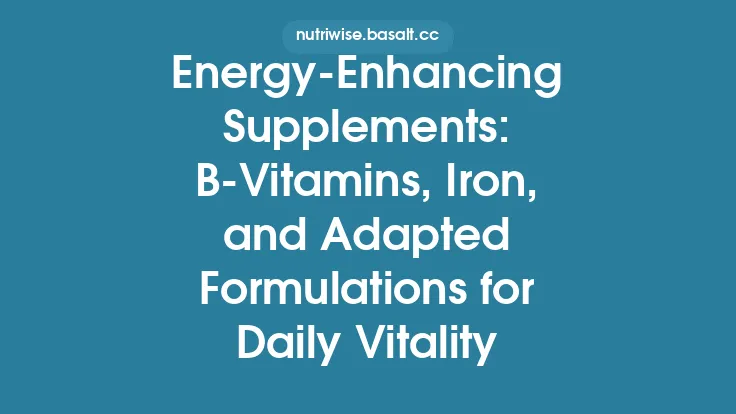Athletes and active adults place unique physiological demands on their bodies that differ markedly from those of sedentary individuals. While a well‑balanced diet remains the cornerstone of performance and health, strategic supplementation can fill gaps, enhance training adaptations, and accelerate recovery. This article outlines evidence‑based, population‑specific supplement strategies tailored to the needs of athletes and active adults, covering macronutrient support, performance‑enhancing agents, recovery aids, micronutrient optimization, timing considerations, safety, and practical implementation.
Understanding the Demands of Active Lifestyles
Energy turnover and substrate utilization – Endurance training relies heavily on oxidative metabolism of carbohydrates and fats, whereas high‑intensity, short‑duration efforts depend on phosphocreatine and glycolytic pathways. The balance of these systems shifts across training cycles (e.g., base building, competition, taper).
Mechanical stress and tissue remodeling – Repetitive loading stimulates muscle protein synthesis (MPS), collagen turnover, and bone remodeling. Adequate amino acids, vitamin C, and minerals such as calcium and magnesium are essential for these processes.
Neuro‑endocrine stress – Intense training elevates cortisol and catecholamines, which can impair recovery if not counterbalanced by adequate nutrition and sleep. Certain supplements (e.g., adaptogenic herbs, omega‑3 fatty acids) may modulate the stress response.
Hydration and electrolyte balance – Sweat losses vary with climate, intensity, and individual sweat rate. Sodium, potassium, magnesium, and chloride must be replenished to maintain plasma volume and neuromuscular function.
Understanding these physiological stressors guides the selection of supplements that complement training goals and individual variability.
Core Nutrient Foundations
| Nutrient | Primary Role for Athletes | Typical Dietary Sources | Supplement Rationale |
|---|---|---|---|
| Protein (high‑quality) | Provides essential amino acids for MPS; supports repair and adaptation | Lean meats, dairy, legumes, soy | Whey, casein, plant‑based blends can ensure 1.6–2.2 g·kg⁻¹·day⁻¹ intake, especially when whole‑food protein is insufficient |
| Carbohydrate | Refuels muscle glycogen; fuels high‑intensity work | Grains, fruits, starchy vegetables | Maltodextrin, dextrose, or mixed‑carb powders aid rapid glycogen restoration post‑exercise |
| Creatine monohydrate | Increases phosphocreatine stores, enhancing ATP regeneration for short bursts | Small amounts in meat/fish | 3–5 g·day⁻¹ after a loading phase (optional) improves strength, power, and lean mass |
| Omega‑3 fatty acids (EPA/DHA) | Anti‑inflammatory, supports membrane fluidity, may improve endurance efficiency | Fatty fish, algae | 1–3 g·day⁻¹ can attenuate exercise‑induced inflammation and aid joint health |
| Vitamin D | Calcium homeostasis, muscle function, immune modulation | Sunlight, fortified foods, fatty fish | 1000–2000 IU·day⁻¹ (or higher if deficient) supports bone health and muscle performance |
| Magnesium | Cofactor for ATP production, muscle relaxation, electrolyte balance | Nuts, seeds, whole grains | 300–400 mg·day⁻¹ (as citrate or glycinate) helps prevent cramps and supports recovery |
These core nutrients should be secured through diet first; supplementation is employed when intake is inadequate, training volume is high, or specific performance goals demand it.
Performance‑Enhancing Supplements
- Creatine Monohydrate
*Mechanism*: Increases intramuscular phosphocreatine, facilitating rapid ATP regeneration during high‑intensity bouts.
*Evidence*: Consistently improves maximal strength (≈5–15 %), sprint performance, and lean body mass across a wide range of sports.
*Protocol*: 0.1 g·kg⁻¹·day⁻¹ for 5–7 days (loading) followed by 3–5 g·day⁻¹ maintenance, or a straight 3–5 g·day⁻¹ regimen without loading.
- Beta‑Alanine
*Mechanism*: Precursor to carnosine, a pH buffer in skeletal muscle that delays acidosis during high‑intensity exercise.
*Evidence*: 2–5 % improvements in performance lasting 1–4 minutes (e.g., 400‑m run, rowing).
*Protocol*: 4–6 g·day⁻¹ split into 2 g doses to minimize paresthesia; loading period of 4–6 weeks.
- Caffeine
*Mechanism*: Antagonizes adenosine receptors, increasing alertness, reducing perceived effort, and enhancing fatty‑acid mobilization.
*Evidence*: 3–6 mg·kg⁻¹ taken 30–60 min pre‑exercise improves endurance time‑to‑exhaustion and power output.
*Protocol*: Individual tolerance testing; avoid excessive dosing (>9 mg·kg⁻¹) to limit side effects.
- Nitrates (Beetroot Juice)
*Mechanism*: Converts to nitric oxide, improving vasodilation and mitochondrial efficiency.
*Evidence*: 0.5–0.7 mmol·kg⁻¹ (~200 ml beetroot juice) 2–3 h before exercise can reduce oxygen cost of submaximal effort and improve time‑trial performance.
- Branched‑Chain Amino Acids (BCAAs)
*Mechanism*: Leucine stimulates MPS; may reduce central fatigue by competing with tryptophan for transport across the blood‑brain barrier.
*Evidence*: Benefits are modest when total protein intake is already adequate; may be useful during prolonged training when protein intake is limited.
- Adaptogenic Herbs (e.g., Rhodiola rosea, Ashwagandha)
*Mechanism*: Modulate the hypothalamic‑pituitary‑adrenal axis, potentially reducing perceived exertion and improving recovery.
*Evidence*: Some trials show 2–5 % gains in VO₂max or strength; effects are strain‑ and dose‑dependent.
Recovery‑Focused Supplements
| Supplement | Primary Recovery Benefit | Typical Dose | Timing |
|---|---|---|---|
| Whey Protein (fast‑digesting) | Rapid provision of essential amino acids, especially leucine, to trigger MPS | 20–30 g (≈0.3 g·kg⁻¹) | Within 30 min post‑exercise |
| Casein Protein (slow‑digesting) | Sustained amino acid release, supports overnight recovery | 20–40 g | Before sleep |
| Carbohydrate‑Protein Blends | Replenish glycogen while stimulating MPS; improves net protein balance | 3:1 or 4:1 carb:protein ratio, 0.5–1.0 g·kg⁻¹ total | Immediate post‑exercise |
| Glutamine | May aid immune function and gut integrity under heavy training loads | 5–10 g | Post‑exercise or before bed (optional) |
| Tart Cherry Juice | Polyphenols with anti‑inflammatory and antioxidant properties; reduces muscle soreness | 30 ml concentrate or 240 ml juice | 1–2 h pre‑exercise and/or daily for 3–5 days post‑exercise |
| Omega‑3 (EPA/DHA) | Attenuates exercise‑induced inflammation, supports joint health | 1–3 g | With meals, daily |
| Magnesium Glycinate | Supports muscle relaxation, reduces cramping | 200–400 mg elemental Mg | Evening, with dinner |
Combining protein with carbohydrate in the immediate recovery window maximizes glycogen resynthesis (≈1.0–1.2 g·kg⁻¹·h⁻¹) and potentiates MPS. For endurance athletes, a higher carbohydrate proportion is often warranted, whereas strength athletes may prioritize a higher protein ratio.
Hydration and Electrolyte Management
- Sodium – Primary determinant of fluid retention; replace 300–600 mg·L⁻¹ of sweat loss for most athletes.
- Potassium – Supports cellular excitability; 200–300 mg·L⁻¹ in sports drinks helps maintain muscle function.
- Magnesium & Calcium – Minor contributors but important for cramp prevention; consider 50–100 mg Mg²⁺ and 100–200 mg Ca²⁺ per liter of fluid for long‑duration events.
Practical approach:
- Pre‑exercise – 5–10 ml·kg⁻¹ of a carbohydrate‑electrolyte solution 2–3 h before activity.
- During exercise – 150–250 ml every 15–20 min, adjusting volume based on sweat rate and ambient conditions.
- Post‑exercise – Replace 150% of fluid lost (weigh before vs. after) with a solution containing 30–60 g carbohydrate and 500–700 mg sodium per liter.
For athletes training in hot climates or at high sweat rates, individualized sweat testing can fine‑tune electrolyte prescriptions.
Micronutrient Optimization
Even well‑fed athletes can experience subclinical deficiencies that impair performance. Targeted testing (serum ferritin, 25‑OH vitamin D, B12, zinc) is advisable for those with high training loads, frequent illness, or dietary restrictions.
- Iron – Essential for oxygen transport; endurance athletes, especially females, are at risk. Supplement 30–60 mg elemental iron (ferrous sulfate or bisglycinate) with vitamin C on an empty stomach if ferritin <30 µg/L.
- Zinc – Supports immune function and testosterone synthesis; 15–30 mg elemental zinc (as picolinate or citrate) may be beneficial for athletes with low dietary intake.
- B‑Vitamins – Cofactors in energy metabolism; a balanced B‑complex (B1, B2, B3, B6, B12, folate) can be useful when dietary intake is marginal, especially for vegans.
- Vitamin C – Antioxidant that aids collagen synthesis; 200–500 mg post‑exercise can support connective‑tissue repair without blunting training adaptations.
Routine blood work, combined with dietary analysis, helps determine whether supplementation is warranted versus dietary modification.
Supplement Timing and Periodization
| Training Phase | Primary Goal | Suggested Supplement Focus |
|---|---|---|
| Off‑Season / General Conditioning | Build base strength, address deficiencies | Full-spectrum multivitamin, omega‑3, creatine, protein, vitamin D |
| Pre‑Season (Volume ↑) | Enhance endurance, maintain muscle mass | Carbohydrate‑protein recovery blends, electrolytes, beta‑alanine, caffeine (strategic) |
| Competition Phase | Maximize power, reduce fatigue | Creatine maintenance, caffeine (race day), nitrates, rapid‑digest carbs, intra‑event electrolytes |
| Taper / Recovery | Optimize repair, prevent over‑training | High‑protein meals, casein before sleep, tart cherry, omega‑3, magnesium, adaptogens |
Timing nuances:
- Pre‑exercise – Caffeine (30–60 min), nitrates (2–3 h), beta‑alanine (chronic loading, not acute).
- During – Carbohydrate (30–60 g·h⁻¹) and electrolytes; optional intra‑exercise BCAAs for very long sessions (>2 h).
- Post‑exercise – Protein + carbohydrate within the anabolic window (≤2 h), followed by anti‑inflammatory nutrients (omega‑3, tart cherry) within 24 h.
Periodizing supplements mirrors training periodization, ensuring that agents supporting acute performance are emphasized during competition, while those promoting long‑term adaptation dominate the off‑season.
Safety, Quality, and Regulatory Considerations
- Third‑Party Testing – Choose products certified by NSF Certified for Sport, Informed‑Sport, or USP to minimize contamination risk (e.g., prohibited stimulants).
- Label Transparency – Verify that the label lists all active ingredients, dosages, and any proprietary blends (which may obscure actual amounts).
- Interaction Awareness – Some supplements (e.g., high‑dose caffeine) can interact with medications (e.g., beta‑blockers) or exacerbate conditions such as hypertension.
- Upper Intake Limits – Respect established tolerable upper intake levels (ULs) for nutrients like vitamin D (4,000 IU/day for most adults) and magnesium (350 mg supplemental).
- Allergen Management – Even though the focus is not on allergy‑friendly options, athletes with known sensitivities should scrutinize excipients (e.g., soy, dairy, gluten).
Consultation with a sports dietitian, physician, or qualified health professional is recommended before initiating any new supplement regimen, especially for athletes subject to anti‑doping regulations.
Personalization and Monitoring
- Baseline Assessment – Conduct a comprehensive dietary recall, training log, and blood panel to identify gaps.
- Goal‑Specific Protocols – Align supplement selection with measurable objectives (e.g., +5 % 5‑km time, +10 % squat strength).
- Trial Periods – Implement a 4–6‑week trial for each new supplement, tracking performance metrics, perceived exertion, gastrointestinal tolerance, and any side effects.
- Adjustments – Modify dosage or discontinue based on response; for example, if beta‑alanine causes persistent paresthesia, reduce the dose or split it further.
- Long‑Term Tracking – Re‑evaluate blood markers every 3–6 months to ensure nutrient status remains optimal and to detect any emerging deficiencies.
Data‑driven personalization maximizes benefit while minimizing unnecessary intake.
Practical Implementation Tips
- Batch Preparation – Pre‑mix carbohydrate‑protein recovery shakes in bulk for post‑training convenience.
- Portable Dosing – Use single‑serve sachets of creatine, caffeine, or electrolytes for on‑the‑go dosing during travel or competition.
- Flavor Management – Mask the taste of bitter supplements (e.g., beta‑alanine) by mixing with flavored sports drinks or smoothies.
- Stacking Safely – Combine creatine with protein and carbohydrate for synergistic uptake; avoid stacking multiple stimulants (caffeine + high‑dose synephrine).
- Education – Keep a personal supplement log noting brand, batch number, dose, timing, and subjective effects; this aids troubleshooting and compliance.
Concluding Thoughts
Tailored supplement strategies for athletes and active adults hinge on a solid foundation of nutrition, a clear understanding of training demands, and meticulous personalization. By prioritizing core nutrients, judiciously incorporating performance‑enhancing agents, supporting recovery with targeted compounds, and respecting safety and quality standards, active individuals can optimize their training outcomes and sustain long‑term health. Continuous monitoring and evidence‑based adjustments ensure that supplementation remains a dynamic, responsive tool—one that complements, rather than replaces, a nutrient‑dense diet and sound training practices.





